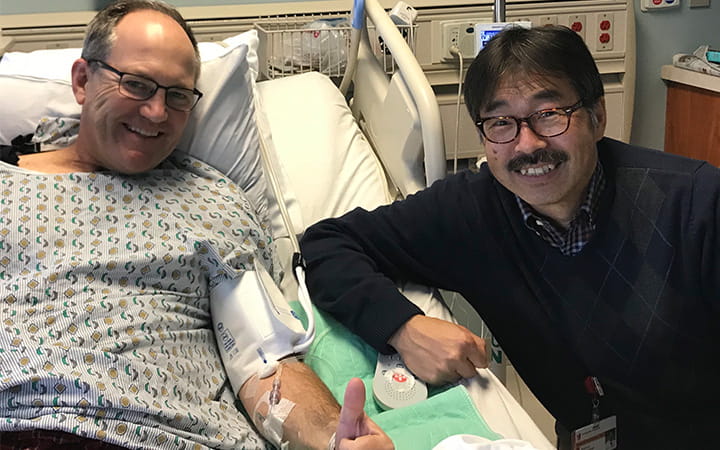Stress Test Reveals Source of Overlooked Symptoms
June 15, 2020

Dan Stadler was walking on a treadmill when the wake-up call sounded.
Just minutes earlier, the Brecksville man had been driving to work and considered blowing off the stress test that would later save his life. He’d been experiencing intermittent stomach pains for a few years that had not resolved, and his primary care physician had recommended a cardiac work-up. Dan reasoned away the pain: It was work stress, the upcoming holidays, maybe an ulcer.
The stress test revealed severe blockage in five coronary arteries – literally a heart attack waiting to happen. The images on the screen were so clearly concerning that the technician ran to find Gerald Burma, MD, while Dan was still on the treadmill.
“When he first told me how terrible it looked, I honestly thought he was kidding,” says Dan, who hadn’t even worked up a sweat on the treadmill yet but quickly realized this was no joke. He was 55 years old and about to face a quintuple cardiac bypass surgery the week of Christmas. “I knew it was the real deal. It was a wake-up call.”
Don’t Ignore Warning Signs
Doctors everywhere are finding unfortunate examples of patients overlooking symptoms of serious health crises like heart attacks and stroke. An April article in MedPage Today reported a 38 percent drop in cardiac catheterization lab activations for STEMIs – a special kind of heart attack caused by sudden formation of a blood clot.
Some patients assume hospitals are too busy caring for COVID-19 patients or think they can avoid the coronavirus by avoiding the emergency room. The fact is, however, emergency departments and the hospital inpatient critical care units are adept at isolating COVID-19 patients and ensuring safe practices. Hospitals also are at the forefront of reducing spread of the virus by screening employees, patients and visitors, requiring masking and physical distancing of all who enter and adhering to constant sanitization of all surfaces.
Unexplained shortness of breath and tightness or pressure in the chest are not symptoms to ignore, says Dr. Burma, an interventional cardiologist. The catheterization found that all of Dan’s major arteries were occluded, including his right coronary artery and his left anterior descending artery – also known as the widow-maker for its association with a high death risk.
“Chest pain symptoms simply cannot be ignored,” Dr. Burma says. “If you wait too long, the damage is done.”
‘I Should Be Dead’
The father of four boys, who had spent years coaching his sons’ baseball and soccer teams, led an active lifestyle. He had barely begun breathing hard when the technician stopped the treadmill.
“I remember the stress test ended much sooner than I anticipated. I wasn‘t even sweating,” Dan says. “Dr. Burma told me three words I’ll never forget: ‘You failed miserably.’ I realized later I should be dead.”
Two days later, Dan was at University Hospitals Parma Medical Center receiving a cardiac catheterization and meeting with cardiac surgeon Masumi Yamamuro, MD. Watching Dr. Yamamuro explain the seriousness of Dan’s cardiovascular disease and map out his plan to address it was heartening to Dan and his wife Rita.
“He was so thorough and reassuring, yet brutally honest,” says Dan, who recalls the doctor marveling that he was sitting there, alive, with such severe blockages.
The doctor explained the importance of harvesting the strongest vessels from his arms and legs for the coronary bypass grafting. “I knew everything would be ok, because I watched the doctor prepare, and he was ready for anything. He sure knew what do to, and I owe him and his team my life,” Dan says.
Dan resumed activity with outpatient cardiac rehabilitation, where he received supervised instruction on activity, diet and medication from a team that included an exercise physiologist, nurse, dietitian and pharmacist.
Cardiac rehab was cut short in the spring when the pandemic struck but resumed again in May, once hospitals were able to return to non-emergent care.
“I feel so lucky that they had the wisdom and knowledge to guide me through this,” Dan says. “They became my extended family. And Dr. Burma is a wise, great doctor!”
A Fateful Turn
Dan was grateful an experienced team of professionals were ready and waiting to do their part in helping clear his blocked coronary arteries and help his recovery from a near-fatal heart condition. But he realizes that six months earlier, when he was in his car at that stoplight at Route 82 and Brecksville Road, the decision to go to that stress test appointment was completely his.
He knows he made the right choice.
“I’m so glad I went through with that test,” Dan says. “It was clearly much more than a stomach ache, and it was shocking to process how close I came. I have a new lease on life and I take nothing for granted. I truly value each day.”
Related Links
University Hospitals emergency rooms are open 24/7 every day of the year for life-threatening illness or injury. To make an appointment with a UH Harrington Heart & Vascular Institute cardiologist, call 216-844-3800. Learn more about appointment options at University Hospitals.
Tags: Heart Attack Risk, Screenings


